Introduction
At just $259, it’s one of the most accessibly-priced lenses of its type, but it is not without some drawbacks. We’ve already mentioned that the lens lacks autofocus, but like the others (except the Nikon-mount option), the Pentax-mount version requires stopped-down metering (and with that, closing the lens to the shooting aperture) and lacks any data bus connections, so the camera cannot record any EXIF data (such as the aperture setting).
As regards optical construction, however, this lens is bang up-to-date. It adopts 9 elements in 7 groups, with one hybrid-aspherical element, and it features internal focusing, so there’s no lens extension.We’ve tested the Pentax-mount version on range of Pentax models and present the findings in this review of this lens on the excellent, pro-oriented 24-Mpix Pentax K3.
Measurements: Lower-than-expected peak sharpness
Tested on the 24-Mpix Pentax K3 with the anti-aliasing functionality off, the Samyang 85mm F1.4 achieves an excellent DxOMark score of 26 points, which ranks close to the top end of the performance range. Only the Sigma 35mm F1.4 DG HSM A and Pentax’s own smc DA* 55mm F1.4 outperform it, both having higher sharpness; but overall, it is by a narrow margin. The Samyang’s strongest performance is achieved when stopped down to f/5.6, where it has excellent sharpness across the image field, though it has slightly higher sharpness at f/4 in the center (but lower sharpness in the periphery).
Few buy lenses like this without using it wide-open, though be warned it will be difficult to focus accurately using a modern DSLR viewfinder. Nevertheless, we’re happy to report that this lens is well-corrected generally, not just at f/1.4, with very low chromatic aberration measured at just 4 microns wide at its maximum point. It also has very low vignetting, measured evenly at just –0.6 EV to the corners. Bear in mind these results are from a full-frame lens and therefore a larger image circle on a cropped (APS-C) camera like the Pentax K3. The results are likely to be a lot different on Pentax’s pre-announced full-frame model, where weaknesses are often revealed towards the edges of the image circle.
As for sharpness, the Samyang struggles to impress wide-open, as even the centers are somewhat soft. That shouldn’t prove to be an issue for portraiture particularly — after all, the maximum aperture isn’t the most appropriate choice, as depth of field is alarmingly shallow, but the results at f/1.4 are perhaps expected at this price. However, stopping down to just f/1.8 improves sharpness levels noticeably in the center, with the corners much improved at f/2.8 and onwards through f/5.6 and f/8, after which sharpness levels begin to decrease.
Distortion isn’t critical at this focal length, but it is very low anyway at 0.1%, displaying marginal barrel-type distortion that is consistent with rival offerings. More notable is the rather modest transmission score of T1.8, which is –0.8EV below that of the f/1.4 aperture value.
Comparison 1: Samyang 85mm f/1.4 AS IF Pentax vs. Pentax smc D FA MACRO 100mm F2.8 WR vs. Pentax smc DA 70mm F2.4 Limited
The Samyang 85mm f1.4 sits alone in our database of high-speed short telephoto models with a native Pentax mount; nevertheless, we can compare it with the full-frame Pentax smc D FA Macro 100mm F2.8 WR. At $589, macro lenses are often used for portraiture, especially when the minimum focus distance of portrait lenses isn’t short enough to crop tightly. The slightly shorter made-for-digital (108mm equivalent) smc DA 70mm F2.4 limited has since been updated with new coatings; however, this is a highly compact and desirable model that’s a lot less intimidating than wide-aperture equivalents. At $545, it is still reasonably-priced, but neither can compete on price with the Samyang, though both offer AF and auto-aperture control, of course.
Both the Pentax models achieve the same DxOMark score of 22 points on the Pentax K3, somewhat below the performance of the Samyang 85mm f1.4 at 26 points. The latter also has the highest peak sharpness of the three, though it is closely followed in turn by the Pentax 70mm f2.4 and 100mm f2.8. That’s not enough to make a difference, but even though the performance of the Samyang is lackluster wide-open, at the more usable aperture of f/2.8, the Samyang is much sharper than either Pentax lens, where both models lack consistent sharpness across the field. Stopped down to f/4, though, and the Pentax models soon start to catch up, particularly the tiny 70mm f2.4 in the center. From f/4 through to f/8 it’s a similar story, but the Samyang has slightly more consistent sharpness across the image field. Chromatic aberration isn’t an issue with any of the three, though the Samyang has a slight lead. The difference in distortion between them is negligible and vignetting is also low, but the 70mm f2.4 has slightly higher levels on account of the smaller image circle.
Conclusion
Reasonably-priced and sharp when stopped down a little, the Samyang 85mm f1.4 AS IF UMC looks like a bargain. However, its popularity will be limited by the stopped-down metering, though the viewfinder will still be reasonably bright at f/2.8 and f/4, of course. Autofocus isn’t offered either, and as it lacks any means of data exchange between the body, there’s no record of the shooting aperture, which can be disconcerting when looking back at images. Providing those shortcomings can be overlooked, there’s no real reason not to like this model. It offers great image quality at a very reasonable price.


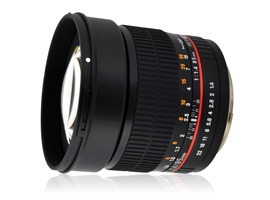



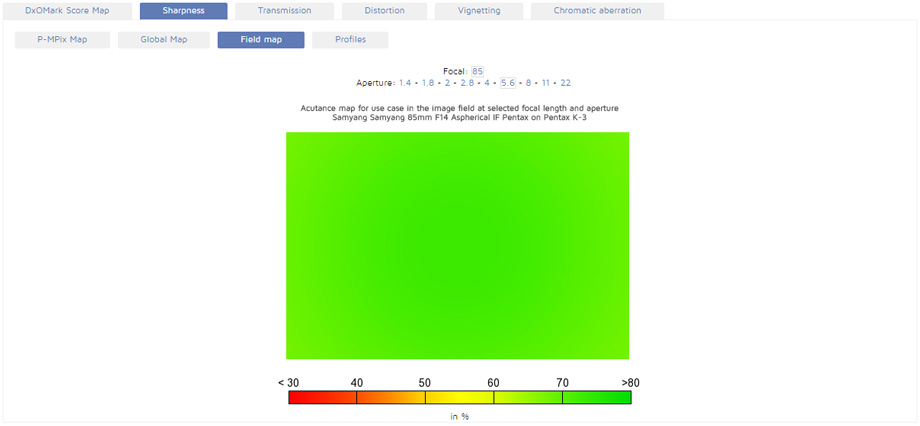



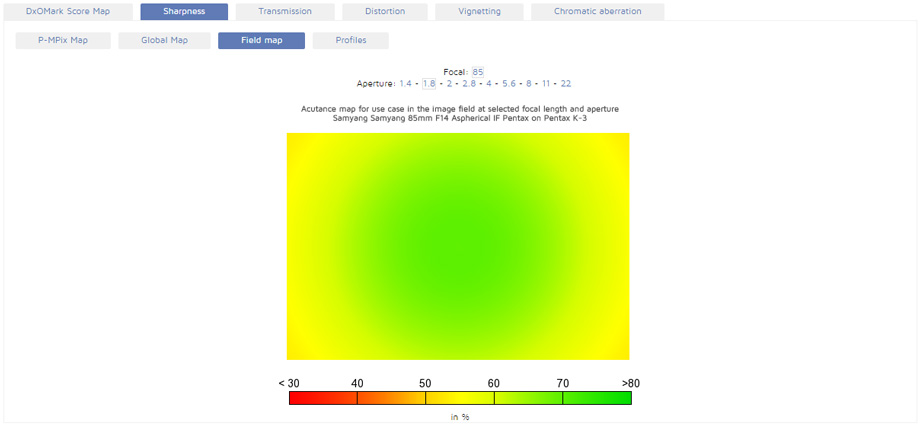



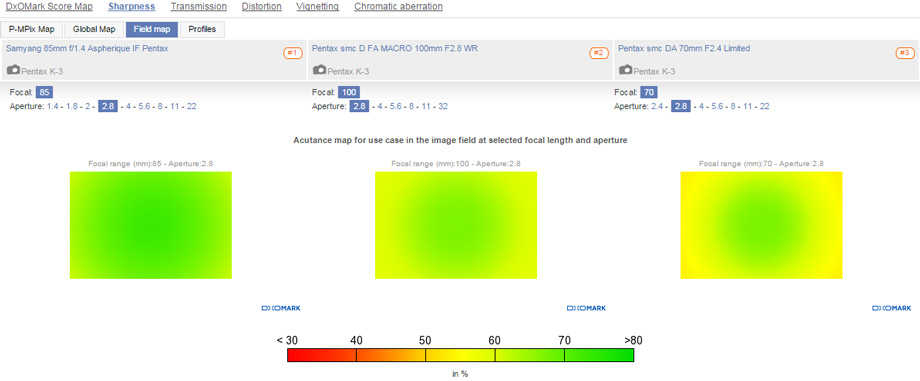

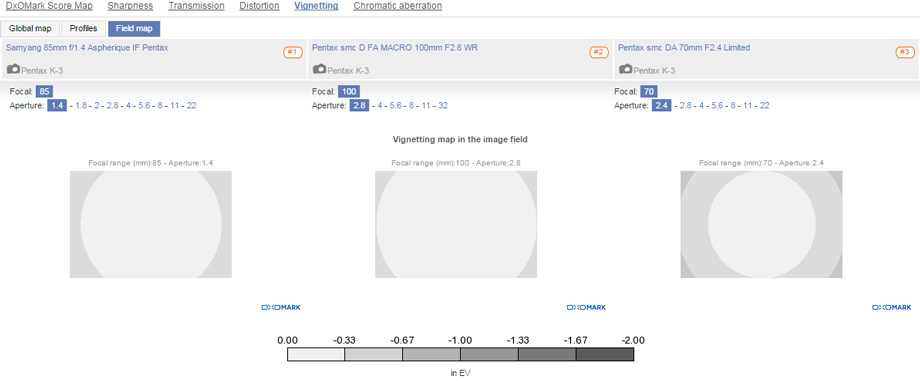
DXOMARK encourages its readers to share comments on the articles. To read or post comments, Disqus cookies are required. Change your Cookies Preferences and read more about our Comment Policy.